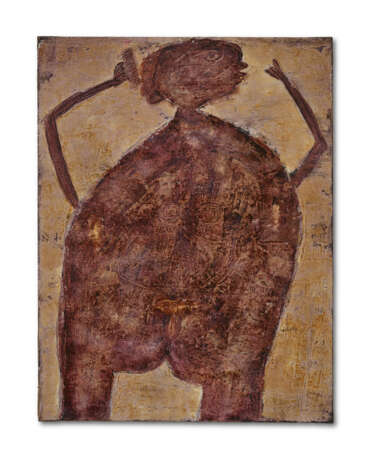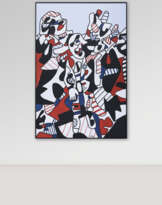ID 832037
Lot 37 | Jean Dubuffet (1901-1985)
Estimate value
€ 1 200 000 – 1 800 000
La fille au peigne
signé et daté 'J. Dubuffet avril 50' (en bas à droite)
huile sur toile
116 x 89 cm.
Peint en 1950
signed and dated 'J. Dubuffet avril 50' (lower right)
oil on canvas
45 5/8 x 35 in.
Painted in 1950
Provenance
Pierre Matisse Gallery, New York.
Pierre Matisse, New York.
Puis par descendance au propriétaire actuel.
Literature
M. Loreau, Catalogue des travaux de Jean Dubuffet: Corps de dames, Fascicule VI, Paris, 1965, no. 84 (illustré, p. 63).
Exhibited
New York, Pierre Matisse Gallery, Exhibition of Paintings by Jean Dubuffet, janvier-février 1951, no. 13 (illustré).
Paris, Musée des Arts Décoratifs, Jean Dubuffet 1942-1960, décembre 1960-février 1961, no . 67 (illustré, pl. 29).
New York, Museum of Modern Art; Art Institute of Chicago et Los Angeles County Museum of Art, The Work of Jean Dubuffet, février-avril 1962.
Londres, Tate Gallery, Jean Dubuffet: paintings, avril-mai 1966, no. 34 (illustré, p. 29).
Amsterdam, Stedelijk Museum, Jean Dubuffet, juin 1966, no. 27 (illustré).
Special notice
Artist's Resale Right ("droit de Suite").
If the Artist's Resale Right Regulations 2006 apply to this lot, the buyer also agrees to pay us an amount equal to the resale royalty provided for in those Regulations, and we undertake to the buyer to pay such amount to the artist's collection agent.
ƒ: In addition to the regular Buyer’s premium, a commission of 5.5%
inclusive of VAT of the hammer price will be charged to the buyer.
It will be refunded to the Buyer upon proof of export of the lot
outside the European Union within the legal time limit.
(Please refer to section VAT refunds)
Post lot text
« L'idée qu'il existe des objets beaux et des objets laids, des gens dotés de beauté et d'autres qui ne peuvent y prétendre, n'a sûrement pas d'autre fondement que la convention… et je déclare cette convention malsaine. » (Jean Dubuffet)
Avec sa forme monumentale inscrite sur la toile, La fille au peigne est une œuvre rare remontant au début de la série majeure de Jean Dubuffet, Corps de Dames. Dans des teintes riches et terreuses, les contours primitifs du corps d'une femme se déploient sur la surface, comme s'ils étaient sculptés dans une roche ancienne ; ses bras sont levés en une salutation sauvage, une main brandissant un peigne. Créés entre avril 1950 et février 1951, les Corps de Dames comptent parmi les œuvres les plus importantes et les plus célèbres de Dubuffet, présentes dans des institutions telles que le Museum of Modern Art de New York, le Philadelphia Museum of Art, la Tate de Londres et la Fondation Beyeler de Bâle. Elles ont non seulement marqué un nouveau chapitre vital dans le langage pictural de l’artiste, en transformant le corps humain en un paysage matériel sensuel, mais ont également incarné un défi révolutionnaire par rapport aux conventions esthétiques. Présentée à l'occasion de la première exposition de la série à la galerie Pierre Matisse de New York en 1951, ainsi que lors de rétrospectives majeures au Museum of Modern Art (1962) et à la Tate Gallery (1966), cette œuvre libère le corps féminin des conceptions archaïques de la beauté, le transformant en un lieu d'énergie viscérale et spirituelle.
La série Corps de Dames a provoqué une onde de choc dans le monde de l'art. Contemporaines des Femmes de Willem de Kooning - un ensemble d'œuvres inconnues de Dubuffet à l'époque - elles s'insurgent contre les idéaux de beauté « misérables et des plus déprimants, hérités des Grecs et cultivés par les couvertures de magazines ». « L'idée qu'il existe des objets beaux et des objets laids, des gens dotés de beauté et d'autres qui ne peuvent y prétendre, n'a sûrement pas d'autre fondement que la convention », explique Dubuffet, « ... et je déclare cette convention malsaine » (J. Dubuffet, « Préface 1952 », reproduite dans The Work of Jean Dubuffet, cat. exp. Museum of Modern Art, New York 1962, p. 64). En choisissant le corps féminin comme véhicule pour exprimer cette conviction, Dubuffet riposte avec puissance à des siècles de tradition : ses femmes défient tout sens de la proportion classique, leurs formes se dilatant dans toutes les directions sur la toile. Elles ne sont plus sereines et équilibrées, mais brutes et animales ; leur peau, autrefois lisse comme la porcelaine, est noueuse, granuleuse et vivante. Ici, l'image d'une femme se peignant les cheveux - un clin d'œil, peut-être, aux muses de Renoir, Degas et autres - semble fonctionner comme une sorte de sarcasme spirituel : son œil fixe le regard du spectateur avec un sentiment d'ironie conspiratrice.
La position esthétique de Dubuffet - exposée par la suite dans sa célèbre conférence « Anticultural Positions » au Arts Club de Chicago en décembre 1951 - est profondément influencée par son engagement dans l' « art brut ». Depuis le milieu des années 1940, il se plonge dans l'étude de l'art produit en dehors des limites de l'enseignement et de la culture traditionnels, observant les dessins et les peintures d'enfants, de patients psychiatriques et de tribus nomades lointaines. Il considère que le dépouillement des conventions apprises peut nous permettre d'entrevoir la « vérité » brute et intacte de l'esprit humain : cette révélation va inspirer des artistes tels que Georg Baselitz et Jean-Michel Basquiat. Par leurs topographies riches et complexes, ses Corps de Dames semblent unir le corps directement avec la terre. Dubuffet décrit la combinaison de « textures rappelant la chair humaine ... avec d'autres textures [qui] suggèrent plutôt la terre et des choses comme l'écorce, les rochers, les éléments botaniques et géographiques » (J. Dubuffet, cité dans Jean Dubuffet : Paintings, cat. exp. Tate Gallery, Londres 1966, p. 29). Dans la présente œuvre, la femme de Dubuffet n'est plus seulement une muse, mais plutôt une source d'alchimie matérielle à part entière, commandant les forces picturales élémentaires qui tourbillonnent autour d'elle.
"The idea that there are beautiful objects and ugly objects, people endowed with beauty and others who cannot claim it, has surely no other foundation than convention … and I declare that convention unhealthy." (Jean Dubuffet)
With its monumental form emblazoned upon the canvas, La fille au peigne is a rare early work from Jean Dubuffet’s seminal series Corps de Dames. In rich, earthen hues, the primal contours of a woman’s body billow across the surface, as if carved into an ancient rockface; her arms are raised in wild salutation, one hand brandishing a comb. Created between April 1950 and February 1951, the Corps de Dames stand among some of Dubuffet’s most important and celebrated works, represented in institutions including the Museum of Modern Art, New York, the Philadelphia Museum of Art, Tate London and the Fondation Beyeler, Basel. They not only marked a vital new chapter in his painterly language, transforming the human body into a sensuous material landscape, but also encapsulated his revolutionary challenge to aesthetic convention. Included in the series’ landmark debut at Pierre Matisse Gallery, New York in 1951, as well as in major retrospectives at the Museum of Modern Art (1962) and the Tate Gallery (1966), the present work rescues the female body from archaic conceptions of beauty, recasting it as a site of visceral, spiritual energy.
The Corps de Dames sent shock waves through the art world. Contemporaneous with the Women of Willem de Kooning—a body of work unknown to Dubuffet at the time—they railed against the ‘miserable and most depressing’ ideals of beauty, ‘inherited from the Greeks and cultivated by the magazine covers’. ‘The idea that there are beautiful objects and ugly objects, people endowed with beauty and others who cannot claim it, has surely no other foundation than convention’, Dubuffet explained, ‘… and I declare that convention unhealthy’ (J. Dubuffet, ‘Preface 1952’, reproduced in The Work of Jean Dubuffet, exh. cat. Museum of Modern Art, New York 1962, p. 64). By choosing the female body as his vehicle for expressing this belief, Dubuffet offered a powerful riposte to centuries of tradition: his women defied all sense of classical proportion, their forms ballooning across the canvas in all directions. They were no longer serene and poised, but raw and animalistic; their skin, once smooth and porcelain, was gnarled, gritty and alive with texture. Here, the image of a woman combing her hair—a nod, perhaps, to the muses of Renoir, Degas and others—seems to function as something of a witty send-up: her eye fixes the viewer’s gaze with a sense of conspiratorial irony.
Dubuffet’s aesthetic stance—subsequently outlined in his seminal lecture ‘Anticultural Positions’ at the Arts Club of Chicago in December 1951—was deeply informed by his engagement with so-called ‘Art Brut’. Since the mid-1940s he had immersed himself in the study of art produced outside the confines of traditional teaching and culture, looking at the drawings and paintings of children, psychiatric patients and far-flung nomadic tribes. Stripping away learnt convention, he believed, might allow us to glimpse the raw, unsullied ‘truth’ of the human spirit: it was a revelation that would go on to inspire artists from Georg Baselitz to Jean-Michel Basquiat. With their rich, complex topographies, his Corps de Dames seem to reunite the body directly with the earth. Dubuffet described the combination of ‘textures calling to mind human flesh … with other textures [that] suggest rather earth and such things as bark, rocks, botanical and geographical elements’ (J. Dubuffet, quoted in Jean Dubuffet: Paintings, exh. cat. Tate Gallery, London 1966, p. 29). In the present work, Dubuffet’s woman is no longer simply a muse, but rather a source of material alchemy in her own right, commanding the elemental painterly forces that swirl around her.
| Artist: | Jean Dubuffet (1901 - 1985) |
|---|---|
| Art style: | Post War Art |
| Place of origin: | Western Europe, France, Europe |
| Auction house category: | Paintings |
| Artist: | Jean Dubuffet (1901 - 1985) |
|---|---|
| Art style: | Post War Art |
| Place of origin: | Western Europe, France, Europe |
| Auction house category: | Paintings |
| Address of auction |
CHRISTIE'S 8 King Street, St. James's SW1Y 6QT London United Kingdom | |
|---|---|---|
| Preview |
| |
| Phone | +44 (0)20 7839 9060 | |
| Buyer Premium | see on Website | |
| Conditions of purchase | Conditions of purchase |











